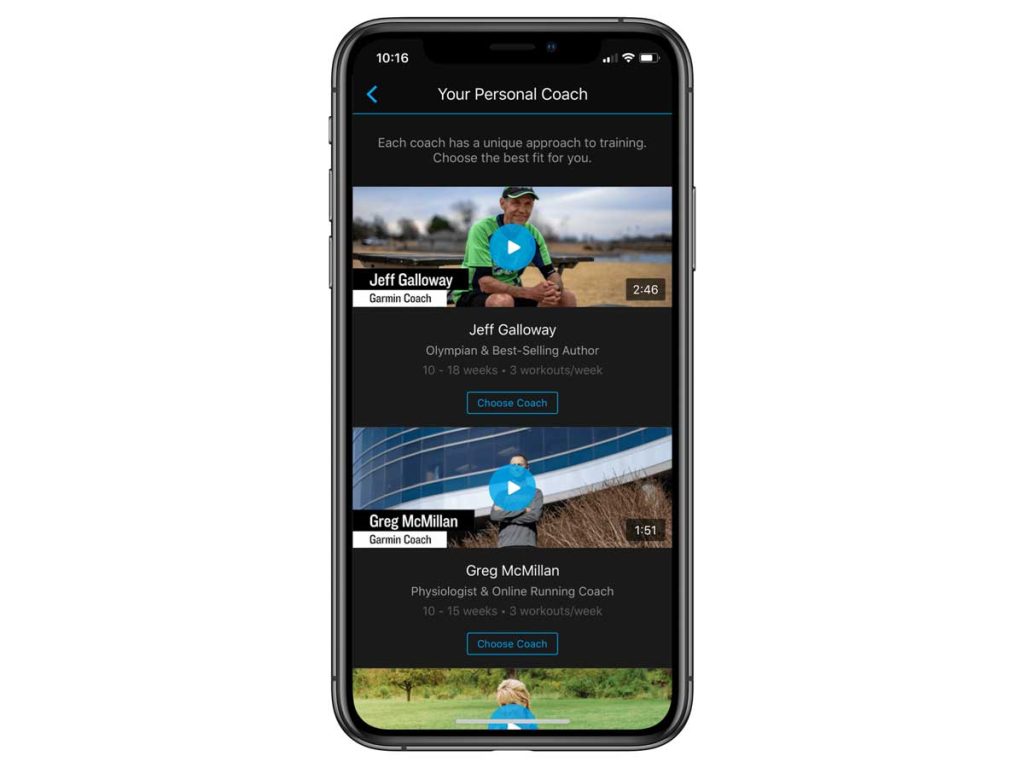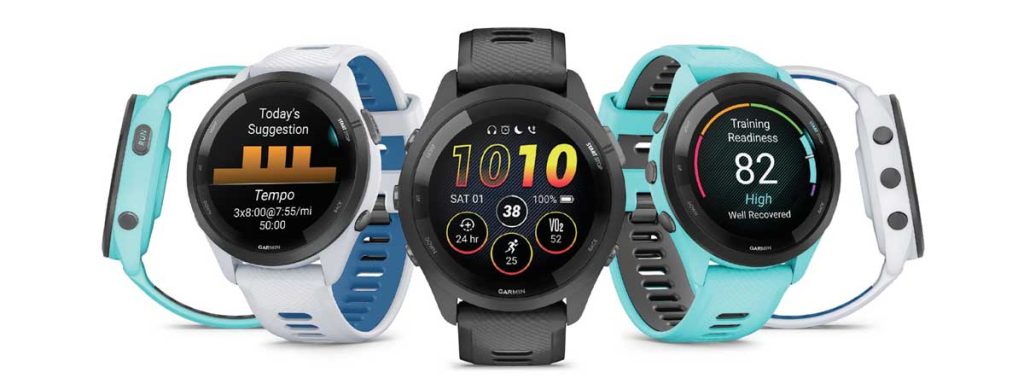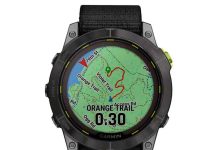We love a good fitness wearable, and we love a good Garmin running smartwatch even more!
Garmin produces some of the best smartwatches for runners and offers a ton of health and fitness metrics to help you improve your training and performance.
Because Garmin offers so many different watch models with pretty big differences in prices, it’s often a challenge to figure out which Garmin watch is right for you and which watch has the features you need and want.
Selecting the right Garmin watch can be overwhelming.
In this article, we highlight some of the best features and metrics you should know about when shopping for a Garmin running smartwatch. Hopefully, we’ll help you determine which one might be your perfect fit.
Contents
Suggested readings
- Apple Watch Ultra vs. Garmin: What’s the right fit for you?
- Wear your Garmin when you sleep to get the most accurate stats for these 10 health metrics
- How to use pre-made or custom workouts in the Garmin Connect app
As an Amazon Associate, we earn from qualifying purchases using links in this post.
What Garmin running smartwatches should you consider?
We’ll start by highlighting the Garmin Connect app and some of the most common (and advanced) features that you’ll find across different Garmin models.
It’s good to know what is offered before you commit to a particular brand and its product.
We’ll then provide you with a few examples of different Garmin running smartwatches with varying features.
The great thing with Garmin is that there’s usually something for everyone because of their price variety and feature-rich products.
The Garmin Connect app
All Garmin running smartwatches work with the companion app Garmin Connect. It’s free, and it’s the place you’ll go to look at any workout analytics or other health metrics.

This app offers a lot of information, and all of it is included at no cost outside of your Garmin watch or tracker purchase. It also stores your health and activity history with weekly, monthly, and yearly averages, so you can check out your trends over time.
And if you like competing with others, you can create and compete in challenges all through the Garmin Connect app.
Garmin coach
The Garmin coach feature, included with Garmin Connect, acts like your virtual coach who helps prepare custom or pre-planned workouts when needed. 
If you want to train for your first race (whether a 5K, 10K, or half marathon), the Garmin coach helps you stay on track with your running.
Long battery life
This is a given. I feel like we all expect long battery life on pretty much anything we buy today. Garmin won’t disappoint!
Depending on which model you choose, you’ll get a staggering minimum of five days of battery life.
Garmin health features
While all Garmin watches track your heart rate and include basic activity metrics like steps, distance, calories burned, and active intensity minutes, they also offer some more advanced health and fitness features.
Wrist-based heart rate 
Paying attention to your heart rate is a good thing to do. Garmin watches track your active heart rate and your resting heart rate using the optical (PPG) sensor built into the back of the device.
The heart rate monitor on your Garmin running smartwatch provides accurate data on how hard you’re working with each run, while your resting heart rate trends help you see the impacts of your training.
Garmin devices also send you heart rate alerts, when it detects an abnormally high or low heart rate for you.
The heart rate sensor is the most important sensor on your watch!
Many of Garmin’s health and activity features depend on analyzing your active and resting heart rate data, including VO2 Max, heart rate variability (HRV), all-day stress tracking, respiration rate, sleep tracking, active calorie burn, cardiorespiratory fitness, and Garmin’s Body Battery.
Pulse Ox 
Garmin’s Pulse Ox (Pulse oximetry) feature is your blood oxygen saturation level, and your Garmin displays it as a percentage of oxygenated blood (SpO2%) available in your blood.
Garmin captures your Pulse Ox using the red and infrared light sensors on the back of the watch. A blood oxygen level of 95% and above is considered normal. Anything below that could be an indication of a health issue.
Your Garmin watch can measure your Pulse Ox during sleep, all day (every 5-15 minutes on some models), and you can also spot-check it.
All-day stress tracking 
Garmin’s all-day stress tracking uses data recorded by the optical heart rate sensor on the back of your device to look at your heart rate variability (HRV) and estimate your physiological stress throughout the day.
Garmin shows you a stress score that’s between 1-100 and corresponds to your autonomic nervous system: the sympathetic (stress: fight-or-flight) and parasympathetic (recovery: rest-and-digest.)
The higher the score, the more stress your body is experiencing from your environment. The lower the score indicates your body is in a more relaxed state.
You can use the stress score to help you identify when you need to take it easy or take a break from whatever or whoever is causing the stress.
Sleep monitoring 
Sleep is so incredibly important for our overall health. In fact, how you recover from a hard workout (e.g., running) and get ready for a new one is by sleeping.
Your body does its best healing when you sleep. Garmin’s sleep monitoring feature gives you all these insights into the time you spend in each sleep stage (light, deep, and REM), how well-rested you are, and how long you need to fully recover (plus many more!)
You also get a daily sleep score, from 1-100, that rates the overall restorative quality of your sleep.
Garmin tracks sleep using your age in combination with your heart rate, heart rate variability, Pulse Ox, respiration rate, and body movement data.
Garmin running features
All of Garmin’s watches include a variety of running profiles to fit your activities. Choose from Running, Outdoor Track Running, Treadmill Running, Indoor Track Running, Trail Running, Virtual Running, and Ultra Running.
Garmin smartwatches, along with Garmin Connect, offer a lot of important features and data for runners that show you how your body responds to your training and your environment. These metrics also help you look at your current performance and how you can improve it.
Built-in GPS 
This is a nice feature to have if you like to run outside. Your watch can track where you go to get accurate route recordings and other metrics like distance and pace.
Garmin includes SatIQ and multi-band GPS. SatIQ extends your watch’s battery life and works in the background to automatically select the right satellite mode for your current environment.
Multi-band GNSS support
This platform connects you to a global navigation satellite system (hence, GNSS) to give you excellent running metrics accuracy.
Where GPS may fail in heavily wooded forests or concrete jungles, GNSS succeeds.
Training and other measurements
With most Garmin smartwatches, you can check out a variety of measurements to support your training and see how you’re improving (or not.)
Honestly, your Garmin watch and the Garmin Connect app offer so many metrics it’s easy to get lost in the data! For runners, these are some of the important metrics to watch.
HRV Status
Understand your health, training, and recovery and how well your body is handling the physical, emotional, and mental challenges of your life and environment through your heart rate variability (HRV.)
HRV is the time in-between your heartbeats, and it’s measured to help us look at our autonomic nervous system (ANS) sympathetic and parasympathetic responses. This is often called our fight-or-flight response (sympathetic) and rest and digest (parasympathetic.)
Generally, as your health improves, your HRV increases, indicating that you’re maintaining a healthy balance between the sympathetic and parasympathetic responses and the more your body can adapt to change.
For runners, monitoring your HRV is a great well to tell if you are overtraining and need some rest and recovery or undertraining and need to increase your exercise exertion.
Garmin watches calculate HRV continuously while you sleep and provides feedback that your HRV is balanced, unbalanced, low, or poor. Garmin uses your HRV status to provide insight into your training status.
VO2 Max 
This score shows your cardiorespiratory fitness and measures how well you perform.
It’s an estimate of the maximum volume of oxygen your body processes per lbs or kg when at your maximum performance. It’s calculated using your heart rate. Your track your VO2 Max directly on the watch and inside the Garmin Connect app.
An improvement in your score means your training is working and that you’re improving your aerobic fitness. When the score dips or stays the same over a prolonged period, you likely need to change your routine.
Garmin uses your VO2 Max trends, along with your resting heart rate and perhaps your body mass index (if available), to calculate your Fitness age by comparing your current VO2 max fitness level to the normal values of people of the same gender at different ages.
Training metrics 
Garmin offers some unique measurements to provide you insight into your training results and impact. These include:
- Training status to let you know if your current routine is productive, peaking, maintaining, or unproductive.
- Training load uses your heart rate data to keep track of how much strain your training provided.
- Training readiness uses data from sleep, HRV, and both training load and status. It lets you know when it’s time to slow down and rest and when you are ready to get up and go. Or when you’re ready for a more difficult challenge.
Recovery time 
Like I said before, sleep is so important. With the recovery time feature, your watch tells you how long you’re going to need to rest before you start that next hard workout.
Sometimes if you go too hard while you’re body is trying to recover, you may do more harm than good.
Advanced running dynamics 
Many Garmin smartwatches can measure a variety of running metrics beyond the basics of pace, distance, and time, all from your wrist or connected running pod. This includes personalized data like cadence, stride length, ground contact time, and more.
Monitoring these metrics can help you adjust your stride and improve your running efficiency.
Garmin watches include up to seven running metrics, which Garmin collectively calls Running Dynamics. These seven metrics are:
- Ground Contact Time: the amount of time each step spends on the ground.
- Ground Contact Time Balance: the balance of time between left and right feet ground contact.
- Cadence: how many steps you take per minute with both feet.
- Stride Length: the distance traveled with each foot (left and right.)
- Vertical Oscillation: the amount of lift (or bounce) in each step when running.
- Vertical Ratio: how well you propel yourself forward with each stride.
- Running Power: a holistic look at your overall effort using many of the metrics above.
More on Running Power 
If you’re seriously into running, you may want to measure more than just your distance, pace, and heart rate. Enter running power!
This advanced feature continuously measures how much power you’re putting out while on a run using metrics like your pace, vertical and horizontal oscillation, elevation, and even air resistance from the wind.
Knowing your running power is important for estimating your energy reserves and recovery time to appropriately pace yourself so you don’t get too tired too quickly in your run.
Following this metric is especially useful when running marathons and long-distance.
All of the watches we recommend in this article feature running power.
For beginners 
If you’re brand new to running or just new(ish), you’re not going to want a top-of-the-line watch that overwhelms you with fitness metrics you’ve never even heard of.
Instead, let’s start with the basics.
Consider the Forerunner 265 or 265S
The Garmin Forerunner 265 is for you! It comes in two sizes, with the larger 265 and the smaller 265S, so there’s a good fit for every wrist size!
This model is great for runners, even first-timers. It offers all your running metrics, including vertical oscillation, cadence, and stride length, from your watch without any additional accessories (the older 255 Series can do this too but requires Garmin’s Running Dynamics Pod or the HRM-Pro chest heart monitor.)
You get a host of fitness and health features on your Garmin Forerunner 265, including GPS and some of Garmin’s signature features like the body battery and live tracking so family and friends can follow your route and know exactly where you are, and Garmin’s unique training features (performance condition, training status, training acute load, and training effect.)
You get 8 GB on the 265, along with sleep tracking and scoring, stress tracking, heart rate variability (HRV) and VO2 Max status, recovery time estimate, blood oxygen saturation monitoring, multisport and triathlon modes, and Garmin coach.
The battery can last up to 13 days in smartwatch mode. Using GPS modes or music significantly reduces the battery from multi-day to less than a day.
Plus, the Forerunner 265 is one of the lightest (less than 2 ounces or 50 grams) and most affordable and feature-rich smartwatches on the market today!
And the screen is bright and easy to read with its AMOLED display that features an ambient light sensor to adjust to your light conditions automatically.
The main downside of the older 255 models was that they did not have a touchscreen. Instead, you used the side buttons to navigate. However, the updated 265 model now offers a touchscreen!
For intermediate and advanced runners 
If you’ve been at it for a while and want to progress beyond your basic Garmin running smartwatch, now’s the time to step it up. In addition to the entry-level features, you’ve got the option to go advanced.
Built-in maps 
For example, if you’re training for a triathlon, you’ll probably be covering a lot of ground.
The best Garmin running smartwatches include full-color, built-in, and high-resolution maps right on the watch’s face. You’ll be able to follow along no matter where you run, bike, or swim!
Using the GNSS system, these advanced smartwatches provide full-color mapping with turn-by-turn navigation, round-trip routing, and more mapping and route planning features.
Along with mapping, you also get support for dual grid coordinates (latitude and longitude along with position format.) So you know your precise location to get help when two sets of coordinates are needed.
Real-time stamina and other training planning tools
The more advanced Garmin watches offer some excellent training features not offered by the beginner’s model, including an important running metric Garmin calls real-time stamina.
Your stamina is another way of describing your enduring physical fitness level. Watches equipped with this help determine how fit you are and how efficiently your body works.
It’ll also keep tabs on your exertion levels to know when it’s time to rest and when it’s time to go.
Real-time stamina is just one option in Garmin’s advanced training features. You also get information to help you plan and analyze your training, including heat and altitude acclimation and things like a round-trip course creator using Garmin’s Trendline Popularity Routing.
And if you like to race against others, the 965 allows you to load both Garmin and Strava Live Segments, so you can start and finish a segment from your watch alone.
Live Segments are virtual race courses created by users that rank your race results against others in the Garmin Connect and Strava communities.
Consider the Forerunner 965 
The Garmin Forerunner 965 is a great option as you grow your running game!
You get all the features of the 265 and more, including dual grid coordinates and topographical maps, a real-time stamina score, a training readiness score, heat and altitude acclimation, advanced cycling dynamics, and support for Garmin and Strava Live Segments.
The Forerunner 965 also supports Garmin’s Group Live Track feature, which helps you keep track of everyone you’re running or riding with so no one gets lost from the pack.
Like the 265, the 965 includes all your running metrics, including vertical oscillation, cadence, and stride length, without any additional accessories.
Additionally, you can pair the 965 with the Garmin Golf app and access all the Garmin Golfing features. 
The 965 is a touchscreen model that offers 32 GB of onboard storage with a battery that lasts up to 23 days in smartwatch mode. Using GPS modes or music significantly reduces the battery from multi-day to a couple of days or less.
There aren’t many downsides to the 965! You get all the same features as the higher-end models, like the Fenix, for a lot fewer dollars and cents!
For elite and professional runners 
Okay, these are the big players in the game. If you’re conquering things like marathons, triathlons, or iron man, then a Garmin running smartwatch of this caliber is for you.
Consider the Enduro 2
The Enduro comes with solar charging, a long GPS battery life, flashlight mode, and built-in mapping for adventures near and far, and it includes a water rating of 10 ATM (withstands pressure up to a depth of 100 meters) allowing diving into the water and uses with high-speed water sports.
The watch even includes a jet lag adviser feature that provides guidance for reducing jet lag before, during, and after your trips with advice on how to acclimate to your destination’s time zone and mitigate any jet lag symptoms. 
And the Enduro withstands harsh conditions with a case made from fiber-reinforced polymer, a Power Sapphire lens, and a titanium bezel and rear cover.
And its screen is built to be seen in all types of lighting conditions, including bright sunlight, with its sunlight-visible, transflective memory-in-pixel display.
- GO TO THE EXTREMES WITH THE GARMIN ENDURO 2 ULTRAMARATHON RUGGED SMART WATCH: Garmin's multisport...
- GARMIN GPS WATCH WITH LED FLASHLIGHT: The Enduro 2 sports, outdoors, and exercise watch features a...
Where the Enduro really shines is its excellent battery life, designed for the backcountry.
You’ll get up to 46 days with solar charging or even up to 550 days with solar charging using battery saver watch mode. For use with GPS, you get 150 hours with solar, and with all satellite systems, up to 96 hours with solar.
The only downside of the Enduro is that the current model (Enduro 2) requires you to add a Garmin Dynamics Running Pod or other supported accessory to get all your advanced running metrics, like running dynamics, vertical oscillation, cadence, and your real-time stride length.
- Computes and sends 6 running dynamics metrics to your compatible Device
- Battery life: replaceable battery lasts up to 1 year (assuming 1 hour daily use)
Final thoughts
Purchasing a fancy and expensive smartwatch is a big commitment. You should consider what you hope to use it for and what features the watch offers you.
We hope this article helped highlight the different features you should be aware of when shopping around, and maybe one of these watches listed here is the one you pick!
Do you have a favorite Garmin running smartwatch? Let us know in the comments!
We sometimes use affiliate links in our content from Amazon and others. It doesn’t cost you anything but helps us pay our expenses. Thank you for the support! Last update on 2024-04-19 / Affiliate links / Images from Amazon Product Advertising API























